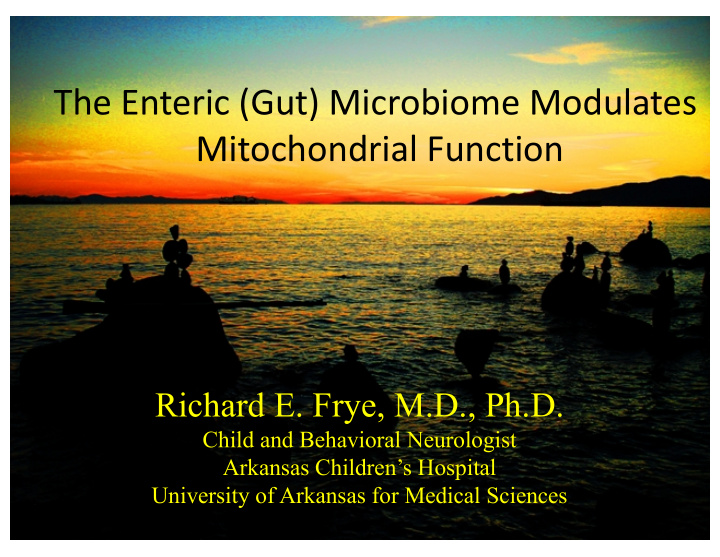



The Enteric (Gut) Microbiome Modulates Mitochondrial Function Richard E. Frye, M.D., Ph.D. Child and Behavioral Neurologist Arkansas Children’s Hospital University of Arkansas for Medical Sciences
The Microbiome and the Microchondria Talking Points The enteric (gut) microbiome has an important influence in on health and disease states in humans. The enteric microbiome influences the human host using chemical mediators, some of which can directly effect mitochondrial function Short chain fatty acids produced by gut bacteria not only modulate mitochondrial function and cellular regulatory pathways, but can also be used as mitochondrial fuels.
The Microbiome and the Microchondria
The Microbiome and Neurodevelopmental Disorders Bacteria use a complex communication network to thrive in an environment
The Microbiome and Neurodevelopmental Disorders The microbiota induces host immune tolerance Segmented Filamoentous Bacteria Gut assocatied lymphoid tissue
The Microbiome and Neurodevelopmental Disorders
The Microbiome and Neurodevelopmental Disorders
The Microbiome and Neurodevelopmental Disorders
The Microbiome and Neurodevelopmental Disorders
The Microbiome and Neurodevelopmental Disorders
The Microbiome and Neurodevelopmental Disorders
The Microbiome and Neurodevelopmental Disorders
The Microbiome and Neurodevelopmental Disorders
The Microbiome and Neurodevelopmental Disorders Autism Spectrum Disorder and the Microbiome
The Microbiome and Neurodevelopmental Disorders Propionic Acid Model of Autism: Animal Models
The Microbiome and Neurodevelopmental Disorders
The Microbiome and Neurodevelopmental Disorders
The Microbiome and Neurodevelopmental Disorders Neuropathology Quantification Hippocampus - GFAP 70000 * 60000 Saline PPA500 50000 2 ) * Mean Area ( µ m 40000 30000 * 20000 10000 0 CA1 & CA2 CA3/Dentate Hippocampus Total Propionate increases GFAP, Marker of Reactive Astrocytes and immunoreactivity in hippocampus
The Microbiome and Neurodevelopmental Disorders CD68 marker of Microglia PPA Control (PBS) PPA increases activated microglia (neuroinflammation)
The Microbiome and Neurodevelopmental Disorders Interleukin 6 PBS PPA White Matter Hippocampus
The Microbiome and Neurodevelopmental Disorders Nitrotyrosine Immunoreactivity, a measure of oxidative stress PBS Vehicle High Dose PPA PPA causes increase anti Nitro-tyrosine immunoreactivity in hippocampal formation, a measure of oxidative stress
The Microbiome and Neurodevelopmental Disorders Developmental delay in pups Eye Opening *** ^^ 2 2-VEH (38) ** LPS (42) 5-VEH (43) PPA (47) # eyes open 1 * ** p < .01, *** p < .001: PPA ^^ p < .01: LPS 0 12 13 14 15 16 Post-natal day Developmental milestones are delayed in pups prenatally exposed to PPA and LPS (ie. pinna detachment, incisor eruption). (PPA similar to valproic acid- mitochondrial function/gene expression)
The Microbiome and Neurodevelopmental Disorders Acoustic startle response: Prenatal PPA and LPS produce hyper-sensitivity to stimulus ** 1000 2-VEH ** LPS ** Average startle response 5-VEH 800 PPA ** 600 n = 14-15 per group 400 ** p < .01: LPS, PPA Males higher than females, 200 regardless of treatment. 0 Male Female Sex Other anxiety-like behaviour also present in PPA and LPS animals.
The Microbiome and Neurodevelopmental Disorders Propionic Acid Model of Autism: Parallels of Children with Autism
The Microbiome and Neurodevelopmental Disorders 213 ASD patients screened with acyl-carnitine biomarkers • 74 (35%) with >=3 fasting acyl-carnitine elevations • Acyl-carnitine abnormalities were confirmed in 48% • Corrected prevalence of 17% of ASD children screened. •
The Microbiome and Neurodevelopmental Disorders Autistic Children Rodents
The Microbiome and Neurodevelopmental Disorders Rodents ASD Children
The Microbiome and Neurodevelopmental Disorders Decreased Complex I Activity
The Microbiome and Neurodevelopmental Disorders
The Microbiome and Neurodevelopmental Disorders
The Microbiome and Neurodevelopmental Disorders
The Microbiome and Neurodevelopmental Disorders GI-After = GI Symptoms started after the onset of Autism symptoms GI-Before/Same = GI Symptoms started before or at the same time as Autism symptoms
The Microbiome and Neurodevelopmental Disorders Early Immune Activation Model of Autism: Animal Model and Probiotic Treatment
The Microbiome and Neurodevelopmental Disorders
The Microbiome and Neurodevelopmental Disorders
The Microbiome and Neurodevelopmental Disorders
The Microbiome and Neurodevelopmental Disorders
The Microbiome and Neurodevelopmental Disorders
The Microbiome and Neurodevelopmental Disorders
The Microbiome and Neurodevelopmental Disorders
The Microbiome and Neurodevelopmental Disorders
The Microbiome and Neurodevelopmental Disorders
The Microbiome and Neurodevelopmental Disorders
The Microbiome and Neurodevelopmental Disorders Microbiota Transfer Therapy (MTT)
The Microbiome and Neurodevelopmental Disorders
The Microbiome and Neurodevelopmental Disorders
The Microbiome and Neurodevelopmental Disorders
The Microbiome and Neurodevelopmental Disorders
Questions
Recommend
More recommend